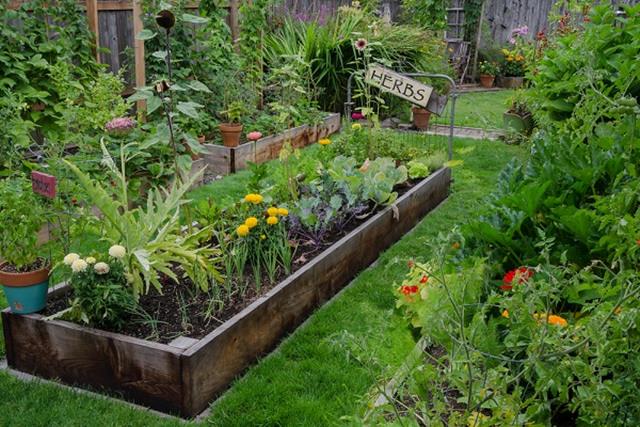Raised bed vegetable gardening is a popular and efficient way to grow your own produce in a small space. By elevating the soil level and creating defined areas for planting, raised bed gardens offer numerous benefits for both gardeners and their crops. In this article, we will explore the ins and outs of raised bed vegetable gardening, from the basics to success stories.
One of the key advantages of raised bed vegetable gardening is its versatility and accessibility. The raised nature of these beds makes them easier to maintain, particularly for those with physical limitations or mobility issues. Additionally, raised beds allow for better control over soil quality and composition, leading to healthier and more productive plants.
In this section, we will delve into the definition and concept of raised bed vegetable gardening, highlighting its unique features and discussing why it has become such a popular choice for home gardeners. We will also touch on some of the key considerations that go into planning and constructing a raised bed garden, setting the stage for further exploration in subsequent sections.
Whether you are new to gardening or looking to refine your techniques, understanding what raised bed vegetable gardening entails is essential for achieving success in your own green space.
Benefits of Raised Bed Vegetable Gardening
Raised bed vegetable gardening offers a number of benefits that make it a great option for your garden. One of the main advantages of raised bed gardening is better soil quality. With raised beds, you have more control over the type and quality of soil used, which can result in healthier and more productive plants. Additionally, the improved drainage and aeration in raised beds can help prevent waterlogging and root rot, leading to healthier plants overall.
Another benefit of raised bed vegetable gardening is the reduced risk of weeds and pests. By creating a defined space for your vegetables, you can more easily manage and control any unwanted growth or insects. This can lead to less time spent weeding and using pesticides, making maintenance of your garden much easier.
Additionally, raised beds provide better accessibility for gardeners. The elevated nature of the beds means less bending and stooping, which can be especially beneficial for individuals with mobility issues or back problems. This accessibility also extends to better organization and layout options for your garden, as you can plan out your beds in a way that makes caring for your plants more efficient.
Finally, raised bed vegetable gardening allows for earlier planting in the spring due to warmer soil temperatures. The structure of the raised bed helps retain heat from sunlight, which can help jump-start your growing season. This means you can enjoy fresh produce from your garden even earlier in the year.
| Benefits | Details |
|---|---|
| Better Soil Quality | More control over soil type and quality resulting in healthier plants |
| Reduced Risk of Weeds and Pests | Easier management and control of unwanted growth or insects |
| Better Accessibility | Elevated nature means less bending, stooping, and better organization options |
How to Choose the Right Location for Your Raised Bed
When it comes to raised bed vegetable gardening, one of the most critical decisions you’ll need to make is where to place your raised bed. The location of your raised bed can significantly impact the success of your garden, so it’s essential to carefully consider several factors before breaking ground.
Sunlight
The first factor to consider when choosing a location for your raised bed is sunlight. Vegetables typically require at least six hours of direct sunlight each day to thrive, so it’s crucial to select a spot that receives adequate sunlight. Before building your raised bed, take note of the sun patterns in your yard throughout the day to identify the sunniest location for your garden.
Drainage
In addition to sunlight, drainage is another essential consideration when choosing a location for your raised bed. It’s important to select a spot with proper drainage to prevent waterlogging, which can lead to root rot and other issues. Avoid low-lying areas or spots where water tends to pool after rainstorms.
Accessibility
Lastly, it’s important to think about accessibility when determining the location of your raised bed. Choose a spot that is easily accessible for planting, watering, and harvesting. Keep in mind that you’ll want to be able to reach all areas of the garden without stepping into the beds themselves, so leave enough space around the perimeter for easy access.
By carefully considering these factors – sunlight, drainage, and accessibility – you can choose the perfect location for your raised bed vegetable garden and set yourself up for success from the start.
Building and Preparing Your Raised Bed
Building your own raised bed for vegetable gardening can be a simple and rewarding project. Here’s a step-by-step guide to constructing and filling your raised bed:
1. Choose the right materials: The first step is to choose the right materials for building your raised bed. You can use wood, concrete blocks, or even metal to construct the sides of your raised bed. When choosing wood, it’s important to select rot-resistant varieties like cedar or redwood to ensure the longevity of your raised bed.
2. Determine the size and shape: Once you have selected your materials, determine the size and shape of your raised bed. Keep in mind that you want to be able to easily reach into the center of the bed from all sides, so it’s best to keep the width at around 4 feet.
3. Construct the frame: Assemble the frame of your raised bed by securing the sides together with screws or nails. Be sure to check that each corner is square before attaching each side.
4. Prepare the soil: After constructing your raised bed, it’s time to fill it with soil. Use a mix of high-quality garden soil, compost, and organic matter to create a nutrient-rich environment for your vegetables.
5. Planting: Once your raised bed is filled with soil, you’re ready to start planting. Follow planting guidelines for each vegetable type and be sure to space plants according to their specific requirements.
By following these steps, you can create a successful raised bed vegetable garden that will yield an abundant harvest of fresh produce while also enhancing the aesthetic appeal of your outdoor space.
Best Vegetables to Grow in Raised Beds
When it comes to raised bed vegetable gardening, the options for what to plant are virtually endless. However, there are certain vegetables that tend to thrive particularly well in the raised bed environment. These plants not only adapt well to the soil conditions and drainage of a raised bed but also make efficient use of space, making them an ideal choice for gardeners with limited space.
Tomatoes
Tomatoes are a popular choice for raised bed gardens due to their high yield and relatively easy maintenance. They thrive in the loose, well-drained soil commonly found in raised beds and can be trained to grow vertically, saving valuable ground space.
Carrots
Carrots are another great option for raised beds because they prefer loose, sandy soil – which is exactly what you’ll find in a well-prepared raised bed. Their long taproots also benefit from the depth of a typical raised bed, allowing them room to grow straight and long without obstruction.
Lettuce
For those looking to grow leafy greens, lettuce is an excellent choice for a raised bed garden. Lettuce grows quickly and doesn’t require much space between plants, making it perfect for the confined quarters of a raised bed. With proper care and regular harvesting, you can enjoy fresh salads straight from your garden all season long.
Other vegetables that thrive in raised beds include peppers, radishes, cucumbers, and spinach. When selecting which vegetables to grow in your own raised bed garden, consider factors such as the climate in your region and your own dietary preferences. With the right choices and care, your raised bed can yield an abundant harvest of delicious vegetables throughout the growing season.
Maintenance Tips for Your Raised Bed Garden
Raised bed vegetable gardening offers numerous benefits, but it also requires proper maintenance to ensure the success of your garden. Keeping your raised bed in top condition involves regular care for your vegetables and the structure itself. Here are some maintenance tips to help you keep your raised bed garden thriving.
First and foremost, regular watering is essential for raised bed vegetable gardening. The soil in raised beds tends to drain quickly, especially if it’s filled with a light, fluffy mix. This means that you’ll need to water your plants more often than you would in a traditional garden. Be sure to check the moisture level of the soil regularly and adjust your watering schedule as needed to keep your vegetables healthy and hydrated.
In addition to watering, it’s important to regularly check for pests and diseases in your raised bed garden. Because the plants are closer together in a raised bed, pests or diseases can spread more easily. Keep an eye out for any signs of trouble, such as holes in leaves or wilting plants, and take action promptly if you notice any issues.
This might involve hand-picking pests off your plants or applying organic pest control methods. By monitoring closely for pests and diseases, you can prevent small issues from turning into major problems that could threaten the health of your entire garden.
| Maintenance Tips | Benefits |
|---|---|
| Regular watering | Healthy and hydrated plants |
| Pest and disease control | Prevention of major problems |
Common Mistakes to Avoid in Raised Bed Gardening
When starting a raised bed vegetable garden, there are common mistakes that many beginners make. Avoiding these pitfalls can lead to a more successful and bountiful harvest. Here are some of the most common mistakes to watch out for and how you can avoid them:
1. Overcrowding: One of the most common mistakes in raised bed vegetable gardening is overcrowding your plants. It’s important to give each plant enough space to grow and thrive. When plants are too close together, they compete for nutrients, water, and sunlight, which can result in stunted growth and lower yields. Be sure to follow spacing guidelines for the specific vegetables you are growing and resist the temptation to squeeze in extra plants.
2. Poor Soil Preparation: Failing to properly prepare the soil in your raised bed can lead to poor plant growth. Before planting, take the time to amend your soil with organic matter such as compost or aged manure. This will provide essential nutrients to your plants and improve drainage in the raised bed. Avoid using heavy clay or compacted soil without making necessary adjustments.
3. Neglecting Watering and Maintenance: Another mistake is neglecting proper watering and general maintenance of your raised bed garden. It’s important to consistently water your plants, especially during hot weather, as the smaller soil volume in a raised bed can dry out quickly. Additionally, regular weeding, pruning, and monitoring for pests or diseases are crucial for maintaining a healthy garden.
By being mindful of these common mistakes in raised bed vegetable gardening, you can set yourself up for a successful growing season with an abundant harvest of fresh produce right from your own backyard. With careful planning and attention to detail, you can avoid these pitfalls and enjoy a thriving raised bed garden filled with vibrant vegetables.
Success Stories
In conclusion, raised bed vegetable gardening offers a multitude of benefits and can be a great option for anyone looking to start a garden. With the ability to control the soil, easier weed control, and better drainage, raised bed gardens provide an optimal environment for growing vegetables. Additionally, they can be placed almost anywhere, making them accessible even for those with limited outdoor space.
When choosing the right location for your raised bed garden, it is important to consider factors such as sunlight, water access, and convenience. Selecting the optimal spot will contribute greatly to the success of your vegetable garden. Once you have chosen a location, building and preparing your raised bed can be done relatively easily with the proper materials and know-how.
When it comes to maintaining your raised bed garden, regular watering and fertilizing are essential for healthy plant growth. Additionally, keeping an eye out for common mistakes such as over-planting or not providing enough support for taller plants will help ensure the success of your garden.
There are numerous success stories of individuals who have achieved thriving raised bed vegetable gardens through careful planning and maintenance. By following their examples and learning from their experiences, you too can create a successful raised bed vegetable garden of your own.

If you’re looking to get into vegetable gardening, or are just looking for some tips on how to make your current garden better, then you’ve come to the right place! My name is Ethel and I have been gardening for years. In this blog, I’m going to share with you some of my best tips on how to create a successful vegetable garden.





